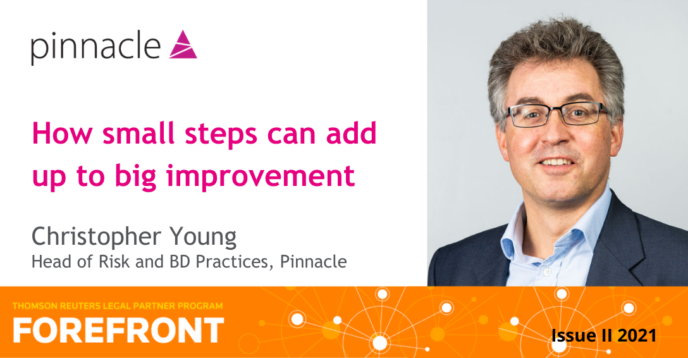
Innovation—a word much bandied about by firms and vendors but also a word that means different things to different people.
Some 15 years ago, in a previous life when working in the angel investment arena, I heard Simon Woodroffe speak. Simon was the founder of YO! Sushi. He talked about making a 1% improvement in his life every day; it being much easier to work out how to make a 1% improvement every day rather than considering how to make a 365% improvement over the next year. Making a 1% improvement every day seems much more achievable than going for the massive change. He was advocating continuous innovation, and it really resonated.
As a consulting firm that is plugged into the legal market by default, we are hearing from firms that there is considerable uncertainty being felt—no surprise—and they appear to be falling into two camps—less of a surprise. There are those that are hunkering down, worried about investing for fear of what the future will bring; and there are those that are looking to capitalize on the momentum for change that they have created over the last year or so.
Interestingly, the split between the camps does not seem to be between those that have seen business volumes hold up and those that are finding life tougher. Indeed, it is hard to find a new business acceptance team that is not busier this year than last year; volumes are up and appear to be holding up. Almost no firm I have spoken to has confidence in its ability to see what the future will bring; the camps seem to be determined by confidence to navigate what the future throws and a belief that continuing to innovate will serve the business well.
With this uncertainty, it strikes me that following the Simon Woodroffe mantra of maintaining the smaller continuous improvements must be good; it avoids the risk of making big mistakes, but it also means that you can make progress and innovate on many fronts.
We are seeing in the business intelligence space with Microsoft’s® ability to insert PowerApps into dashboards, that firms can now turn reporting and information that historically has been presented as “for your information” into “for your action”. Microsoft has been calling this “Actionable Insights”.
The further exploitation of Microsoft Teams is another area of focus. With the collective rapid adoption of Microsoft Teams, there has been a need to integrate it with legacy working practices such as time recording and document management. We are now seeing firms begin to increase their focus on some of the information governance challenges created by the rapid adoption of the software.
Most people working in law firms have the tools to do their jobs. They might not be the best and most efficient, but firms can get most jobs done. If we choose big innovations, we often lose sight of the change management and the user adoption elements that need to be delivered as part of these innovations.
Key in this continuous improvement is to focus on those things that make life easiest; to not pick hard battles as it makes things easier to deliver. In doing our own due diligence around our recent acquisition of Enable and its PitchPerfect software, a common thread that came out of feedback from law firms that have adopted their technology was the fact that it is embedded in Word and PowerPoint®, so users don’t have to go anywhere. If we can improve the tools that individuals use today, it is easier than giving individuals new tools and new places to go.
One of the areas in which we find that driving innovation is hardest is within the business development of firms. It is because much of the change required is of the fee earning community and how they relate with their contacts. It isn’t something that the business development professionals within firms can do for the fee earners. The business development teams that appear to have the most success in enhancing client relationships are those who have managed to sustain small but continuous improvements. They have a relentless focus on these marginal gains through working with individuals and teams, day after day.
With the new normal appearing to be around the corner and massive changes having been pushed into our businesses under pressure, there are probably more opportunities for a 1% improvement every day than ever before. We have pushed through the imperfect and can use the momentum and goodwill to improve on what might have been lifesaving changes. Continuing to drive innovation through our businesses doesn’t need to be through big projects alone.
Article by Christopher Young, Head of Pinnacle Risk and Compliance team
